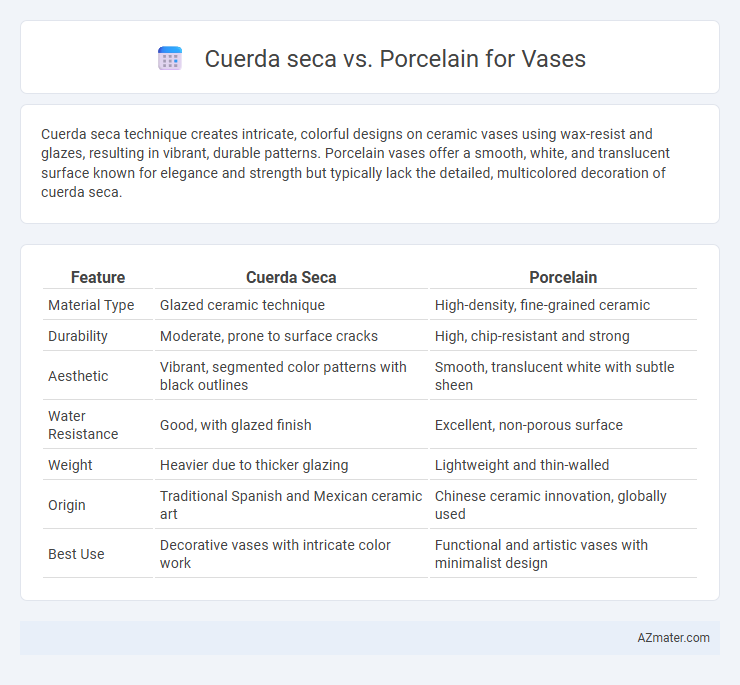Cuerda seca technique creates intricate, colorful designs on ceramic vases using wax-resist and glazes, resulting in vibrant, durable patterns. Porcelain vases offer a smooth, white, and translucent surface known for elegance and strength but typically lack the detailed, multicolored decoration of cuerda seca.
Table of Comparison
| Feature | Cuerda Seca | Porcelain |
|---|---|---|
| Material Type | Glazed ceramic technique | High-density, fine-grained ceramic |
| Durability | Moderate, prone to surface cracks | High, chip-resistant and strong |
| Aesthetic | Vibrant, segmented color patterns with black outlines | Smooth, translucent white with subtle sheen |
| Water Resistance | Good, with glazed finish | Excellent, non-porous surface |
| Weight | Heavier due to thicker glazing | Lightweight and thin-walled |
| Origin | Traditional Spanish and Mexican ceramic art | Chinese ceramic innovation, globally used |
| Best Use | Decorative vases with intricate color work | Functional and artistic vases with minimalist design |
Understanding Cuerda Seca Technique
The Cuerda Seca technique involves applying wax resist lines to separate colored glazes on a ceramic surface, producing intricate, sharp patterns ideal for decorative vases. Porcelain vases, made from fine, white clay fired at high temperatures, emphasize smoothness and translucency but often lack the vibrant, segmented designs characteristic of Cuerda Seca. Understanding Cuerda Seca allows collectors to appreciate the meticulous craftsmanship and the historic significance behind the bold, multi-colored motifs that distinguish these vases from the elegant simplicity of porcelain.
Overview of Porcelain in Vase Making
Porcelain is prized in vase making for its fine, dense composition that allows for intricate designs and a smooth, translucent finish, enhancing both aesthetic appeal and durability. Unlike cuerda seca, which uses colored slip outlines to separate glazes, porcelain offers a seamless surface ideal for detailed hand-painting and glazing techniques. Its high firing temperature imparts resistance to chipping and water absorption, making porcelain vases both functional and elegant art pieces.
Historical Origins: Cuerda Seca vs Porcelain
Cuerda seca, a technique originating in the Islamic world during the 9th century, is characterized by using oily substances to separate colored glazes on ceramic surfaces, preventing them from mixing and creating intricate patterns. Porcelain, first developed in China during the Tang Dynasty (7th-10th centuries) and perfected in the Ming Dynasty, is known for its high-fired, vitrified body and translucent qualities, contrasting with the painted surface decoration of cuerda seca. The historical significance of cuerda seca lies in its decorative glazing method, while porcelain represents a technological advancement in ceramic material and firing processes.
Visual Aesthetics and Design Differences
Cuerda seca vases exhibit intricate, multicolored patterns created by applying a greasy line that resists glaze, resulting in bold, segmented designs with a slightly raised texture. Porcelain vases, known for their smooth, translucent surfaces, often feature delicate, hand-painted motifs and subtle color gradients that emphasize elegance and refinement. While cuerda seca offers vibrant contrasts and a tactile quality, porcelain highlights fine details and a polished, glossy finish that reflects light beautifully.
Durability and Functional Comparison
Cuerda seca vases feature a unique wax resist technique that enhances color vibrancy but can be more prone to chipping compared to porcelain. Porcelain vases offer superior durability due to their dense, non-porous structure, making them highly resistant to scratches, stains, and moisture. Functionally, porcelain is ideal for everyday use and water retention, while cuerda seca pieces serve primarily decorative purposes due to their delicate surfaces.
Craftsmanship Process: Cuerda Seca vs Porcelain
Cuerda seca technique involves applying greasy resist lines to separate colored glazes, requiring precise handcrafting skills to prevent color bleeding during firing. Porcelain crafting demands meticulous shaping and multiple high-temperature firings to achieve its smooth, translucent finish, highlighting the potter's control over temperature and kiln atmosphere. Both methods showcase distinct artisan expertise: cuerda seca emphasizes detailed surface decoration, while porcelain prioritizes form and translucency.
Cost and Accessibility of Each Material
Cuerda seca technique vases typically cost more due to the intricate process involving wax resist and multiple firings, while porcelain vases are generally more affordable and widely accessible thanks to mass production and simpler glazing methods. Porcelain materials are readily available at craft stores and online retailers, making it easier for beginners and casual buyers to obtain. In contrast, cuerda seca vases often require specialized artisanship, resulting in limited availability and higher price points.
Maintenance and Care Requirements
Cuerda seca vases require gentle cleaning with a soft, damp cloth to prevent damage to the intricate colored glazes and avoid harsh chemicals that could degrade the wax resist lines. Porcelain vases are more durable, allowing for mild soap and water cleaning, but care must be taken to avoid abrasive materials that can scratch the smooth surface. Both materials benefit from avoiding extreme temperature changes and direct sunlight to preserve their aesthetic and structural integrity over time.
Artistic Versatility and Customization
Cuerda seca technique offers greater artistic versatility for vases through its bold, segmented color patterns and precise line work, allowing intricate multi-colored designs that enhance visual depth. Porcelain provides a smooth, fine-grain surface ideal for detailed, delicate painting or sculpting, enabling subtle shading and unique textures that can be customized with glazes and finishes. Both methods support customization, but cuerda seca excels in vibrant, graphic motifs while porcelain favors refined, nuanced artistry.
Choosing the Right Vase: Cuerda Seca or Porcelain?
Cuerda seca vases feature intricate, hand-painted designs separated by raised lines of wax, offering vibrant colors and a textured finish that highlights traditional craftsmanship. Porcelain vases provide a smooth, glossy surface with subtle elegance and durability, making them ideal for minimalist or modern interiors. Choosing between cuerda seca and porcelain depends on whether you prefer bold, decorative artistry or sleek, timeless simplicity for your vase collection.

Infographic: Cuerda seca vs Porcelain for Vase
 azmater.com
azmater.com